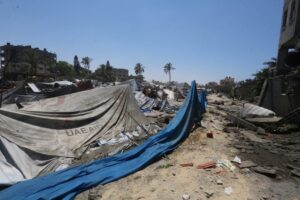Palestine letter: The sorrow after the massacre

The aftermath of the Mawasi massacre, 13 July 2024
Tareq S. Hajjaj writes in Mondoweiss on 17 July 2024:
How can a person recover from the horror of what he saw? How can he live an everyday life after everything that happened to him and all this displacement, destruction, killing, and death? How can a normal person witness all these massacres and see how a person becomes a pile of body parts? Some of them are on the ground, and the remains of “Unknown No. 15” are written next to them. These scenes continue to play out, every day, for months. Can a person ever heal?
An ordinary person who follows the course of the war on television and on social media may experience great sadness as a result of what he sees. But experiencing the massacre and genocide first hand, researching its details, seeing its victims, listening to their stories and their helpless words, then writing their stories, word after word, feeling after feeling – is something else entirely. The writer listens to these stories over and over again, each one reminding him of his own personal experience, to the point that he becomes weak and has no choice but to break down in tears.
Not a single story that I have published from October until now has been devoid of every single one of these emotions. There is not a single story devoid of its owners’ crying. Every family I went to meet in Gaza, the family was sitting in front of me with tears streaming down their face during a conversation. They could not stop, and in every story, I was in front of these people. Despite my persistent attempts to control my tears, I always failed and found myself crying with them and quickly trying to focus again and maintain my role as a journalist.
